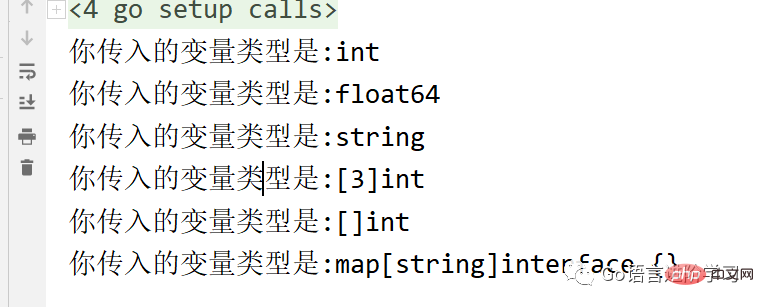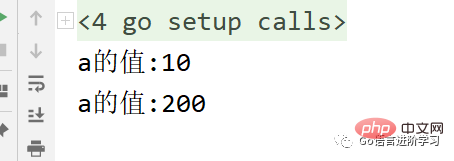An article teaches you the basics of reflection in Go language
What is reflection
Reflection, um..., means reverse, that is, turning things over.
For example, a very simple code like this.
var a int = 3 fmt.Println(a)
Of course we know that the avariable isint type, but thinking about it the other way around, how does the program know that a is What about the int type? ? ?
At this time, you need to use reflection.
Sample code
v := reflect.TypeOf(a) fmt.Println(v)
The two codes are combined into one execution result

The second line of code successfully restored the variable a to int type.
What? ? ? What use are you to me? ? ? ,Um. . . To be honest, I don’t use it too much, but I have to know how to do it.
Reflection (reflect package)
In Go, any variable , both have concrete types and concrete values , just like var a int = 3, The specific type is int, The specific value is 3.
So, the specific type of the variable belongs to reflect.Type , the specific value of the variable belongs to reflect.Value.
And Go provides
##reflect.TypeOf
Get the specific type.##reflect.ValueOf
Get the specific value.
##TypeOf
method can get the # of the variable ##Specific type. There is a need to define a function that can receive any type of data and print the variable type through reflection.
示例代码
函数
func reflectType(x interface{}) {
v := reflect.TypeOf(x)
fmt.Printf("你传入的变量类型是:%v\n",v)
}main
func main() {
var a int = 666
var b float64 = 3.14
var c string = "hello world"
var d [3]int = [3]int{1,2,6}
var e []int = []int{1,2,6,88}
var f map[string]interface{} = map[string]interface{}{
"Name":"张三",
"Age":18,
}
reflectType(a)
reflectType(b)
reflectType(c)
reflectType(d)
reflectType(e)
reflectType(f)
}执行结果

通过reflect.TypeOf方法,完美解决上述需求。
TypeOf 的Name和Kind
这个是啥意思呢??这个在结构体中比较好体现。
简答来说就是TypeOf返回的太笼统了,还有更加细化的类型,通过这俩属性获取。
示例代码
函数
func reflectType(x interface{}) {
v := reflect.TypeOf(x)
fmt.Printf("你传入的变量类型是:%v | Name:%v | Kind:%v\n", v, v.Name(), v.Kind())
}结构体
type Student struct {
Name string
Age int
}main
func main() {
var a int
var b *int
var c []int
var d map[string]interface{}
var e Student
reflectType(a)
reflectType(b)
reflectType(c)
reflectType(d)
reflectType(e)
}执行结果

总结
经过对比,会发现几个特殊问题。
如果变量是指针类型,Name为空,Kind是ptr。
If the variable is a reference type (slice and map) type, Name is empty, only Kind.
If the variable is a structure, Name is the structure name, Kind is struct.
ValueOf
TypeOf can only get the ## of the variable in reverse #Specific type, but you cannot get the specific value, which is a bit unkind.
所以ValueOf就来解决这个问题了,但是ValueOf牛叉的是,它里面还包括了变量类型。
注:ValueOf和TypeOf的Kind属性返回内容是一摸一样的。
需求:定义一个函数,可以接收任意类型,通过反射得出变量类型和变量值。
函数
func reflectType(x interface{}) {
v := reflect.ValueOf(x)
k := v.Kind()
switch k {
case reflect.Int:
fmt.Printf("我是Int类型,我的值是%v\n",v.Int())
case reflect.Slice:
fmt.Printf("我是切片类型,我的值是%v\n",v.Slice(1,2))
case reflect.Map:
fmt.Printf("我是切片类型,我的值是%v\n",v.MapKeys())
//case :可以继续case下去
}
}main
func main() {
var a int = 1
var c []int = []int{1, 5, 7, 19}
var d map[string]interface{} = map[string]interface{}{
"Name": "你好",
"Age": 18,
}
var e Student
reflectType(a)
reflectType(c)
reflectType(d)
reflectType(e)
}执行结果

通过反射设置值
反射还有一个用途,就是动态的修改变量值,可能你暂时体会不到,但是语法还是要学的。
通过反射设置值,需要用到Elem方法,并且传入的必须是指针。
示例代码
函数
func reflectSetValue(x interface{}) {
v := reflect.ValueOf(x)
//kind也必须是Elem调用
var k = v.Elem().Kind()
switch k {
case reflect.Int:
//反射修改必须通过Elem
v.Elem().SetInt(200)
}
}main
func main() {
var a int = 10
fmt.Printf("a的值:%v\n", a)
//反射修改值传入的必须是地址
reflectSetValue(&a)
fmt.Printf("a的值:%v\n", a)
}
执行结果

Summary
We have learned the basic reflection of GoTypeOf, Name and Kind of TypeOf,ValueOf, Set the value via reflection.
whereKind is in Type# Both ## and ValueOf are available, usually TypeOf and ValueOfUse together for better results!
Reflection may not be easy to understand, so you must work harder! persist in! !
The above is the detailed content of An article teaches you the basics of reflection in Go language. For more information, please follow other related articles on the PHP Chinese website!

Hot AI Tools

Undresser.AI Undress
AI-powered app for creating realistic nude photos

AI Clothes Remover
Online AI tool for removing clothes from photos.

Undress AI Tool
Undress images for free

Clothoff.io
AI clothes remover

AI Hentai Generator
Generate AI Hentai for free.

Hot Article

Hot Tools

Notepad++7.3.1
Easy-to-use and free code editor

SublimeText3 Chinese version
Chinese version, very easy to use

Zend Studio 13.0.1
Powerful PHP integrated development environment

Dreamweaver CS6
Visual web development tools

SublimeText3 Mac version
God-level code editing software (SublimeText3)

Hot Topics
 1378
1378
 52
52
 What is the problem with Queue thread in Go's crawler Colly?
Apr 02, 2025 pm 02:09 PM
What is the problem with Queue thread in Go's crawler Colly?
Apr 02, 2025 pm 02:09 PM
Queue threading problem in Go crawler Colly explores the problem of using the Colly crawler library in Go language, developers often encounter problems with threads and request queues. �...
 What libraries are used for floating point number operations in Go?
Apr 02, 2025 pm 02:06 PM
What libraries are used for floating point number operations in Go?
Apr 02, 2025 pm 02:06 PM
The library used for floating-point number operation in Go language introduces how to ensure the accuracy is...
 What should I do if the custom structure labels in GoLand are not displayed?
Apr 02, 2025 pm 05:09 PM
What should I do if the custom structure labels in GoLand are not displayed?
Apr 02, 2025 pm 05:09 PM
What should I do if the custom structure labels in GoLand are not displayed? When using GoLand for Go language development, many developers will encounter custom structure tags...
 In Go, why does printing strings with Println and string() functions have different effects?
Apr 02, 2025 pm 02:03 PM
In Go, why does printing strings with Println and string() functions have different effects?
Apr 02, 2025 pm 02:03 PM
The difference between string printing in Go language: The difference in the effect of using Println and string() functions is in Go...
 Which libraries in Go are developed by large companies or provided by well-known open source projects?
Apr 02, 2025 pm 04:12 PM
Which libraries in Go are developed by large companies or provided by well-known open source projects?
Apr 02, 2025 pm 04:12 PM
Which libraries in Go are developed by large companies or well-known open source projects? When programming in Go, developers often encounter some common needs, ...
 How to solve the user_id type conversion problem when using Redis Stream to implement message queues in Go language?
Apr 02, 2025 pm 04:54 PM
How to solve the user_id type conversion problem when using Redis Stream to implement message queues in Go language?
Apr 02, 2025 pm 04:54 PM
The problem of using RedisStream to implement message queues in Go language is using Go language and Redis...
 What is the difference between `var` and `type` keyword definition structure in Go language?
Apr 02, 2025 pm 12:57 PM
What is the difference between `var` and `type` keyword definition structure in Go language?
Apr 02, 2025 pm 12:57 PM
Two ways to define structures in Go language: the difference between var and type keywords. When defining structures, Go language often sees two different ways of writing: First...
 Why is it necessary to pass pointers when using Go and viper libraries?
Apr 02, 2025 pm 04:00 PM
Why is it necessary to pass pointers when using Go and viper libraries?
Apr 02, 2025 pm 04:00 PM
Go pointer syntax and addressing problems in the use of viper library When programming in Go language, it is crucial to understand the syntax and usage of pointers, especially in...




